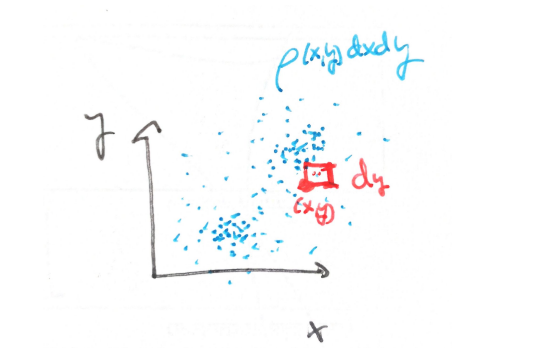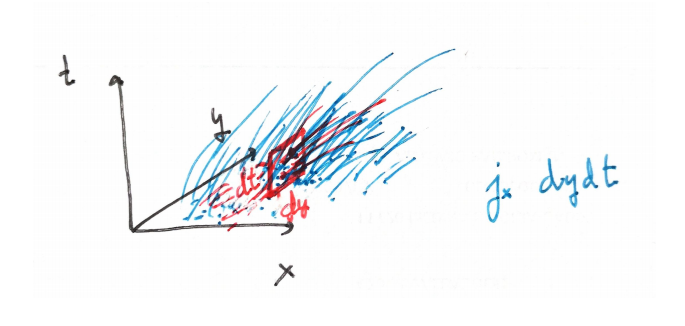Four-current
Related: this video.
Electromagnetic effects happens by the existence of moving particles with charge. We can imagine that we have infinite charged particles, and their movement being described by infinite curves. But this is not the optimal way to think of them.
First of all, recall that when we study a really large number of mass particles in Classical Mechanics is better to pass to Continuum Mechanics. This way, we substitute a huge number of positions by a distribution of mass density (a 3-form, if we are in 3D space). We count how many particles are in a infinitesimal cube centered at $(x,y,z)$ and construct the differential form
$$ \omega=\rho(x,y,z)dxdydz $$that let us recover the mass which is enclosed by a volume $V$ by means of
$$ \int_V \rho(x,y,z)dxdydz $$
In what follows, we will work with two spatial dimensions, to get clearer pictures. So we have a mass density
$$ \omega=\rho(x,y,t)dxdy $$
(observe we have made our density depends on time, by the way).
But this is not the whole story. Because although we let $\rho$ depends on $t$, this does not capture the movement of the infinite particles. The differential form $\omega$ only tell us how many particles are there in the infinitesimal red square in any time $t$. For example, only with $\rho(t,x,y)dxdy$ we cannot distinguish between a bunch of static particles:
and moving particles

So we must include three new quantities to code directions: $j_x$, $j_y$ and $j_z$. Let's speak about $j_x$, the others are analogous: it represents the number of particles that pass through an infinitesimal segment ($dy$ in the picture above) in an infinitesimal amount of time $dt$. If we pass to a spacetime diagram, we observe that we are speaking about something totally analogous to the density, but instead of a pure spatial window (the square $dxdy$) we look at a spacetime window $dydt$

This points to the ideas of Special Relativity, which treats space and time on an equal footing. In fact, we can collect them all in a 4-vector $J=( j_x,j_y,j_z,\rho)$ that transforms well according to Lorentz transformations. It is called the four-current or 4-current. Update: indeed it is a 1-form, see @needham2021visual page 403.
If we use charge instead of mass, we can perform the same analysis. In this case $\rho$ is called charge density and $j=(j_x,j_y,j_z)$ is called current density. Just as mass is data that determines the behavior of a system when gravity acts, $\rho$ and $j$ are data to specify the electromagnetic field.
If we assume that no charge can disappear from one place and appear into another without going through the wall of the laboratory (local charge conservation) we get the continuity equation
$$ \partial_{\mu} J^{\mu}=0 $$or also
$$ \frac{\partial \rho}{\partial t}=-\left(\frac{\partial j_{x}}{\partial x}+\frac{\partial j_{y}}{\partial y}+\frac{\partial j_{z}}{\partial z}\right) $$For more info see The Theoretical Minimun vol 3, page 310 and so on.
________________________________________
________________________________________
________________________________________
Author of the notes: Antonio J. Pan-Collantes
INDEX: